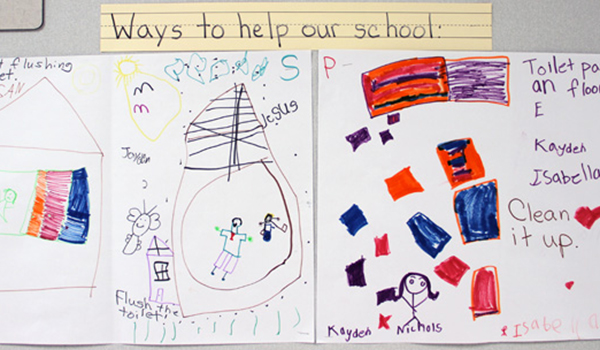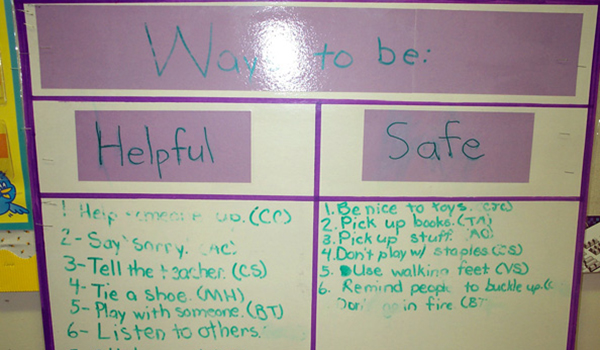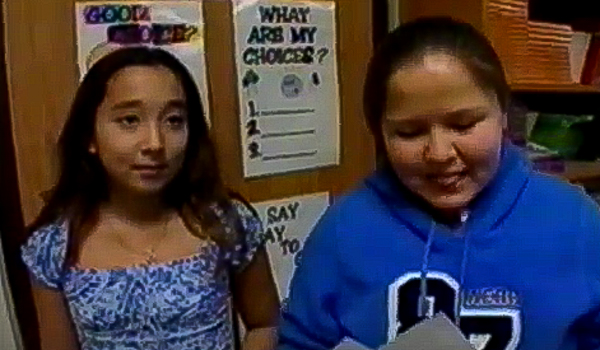
Chapter 6: Encouragement
- Chapter 6: Encouragement Resources
- Encouragement Summary
- 1 - Power of Unity
- 2 - I Love You Rituals - Your Guide For Meaningful Connections
- 3 - Rubin's Story
- 4 - Activity to Encourage Kindness, Helpfulness and Compliance Through Noticing
- 5 - Teachers Encouraging Students
- 6 - Activity to Encourage Children's Strengths Through Noticing
- 7 - The "I See Song"
- 8 - Connecting Rituals
- 9 - Brain Breaks
- 10 - Kindness Tree
- 11 - School-wide Kindness Tree
- 12 - How to Use Jobs
Encouragement Summary
- Power: Unity: We are all in this together.
- Becoming Brain Smart: Encouragement, connection and belonging prime the brain for academic achievement.
- Skill: Notice instead of judge as the basis for encouragement, “You did it! You ___ so____. That was helpful.”
- School Family: The “I See” Song, Connecting Rituals, Ways to Be Helpful, Kindness Tree or Recorder, Job Board, Friends and Family Board/Book
 I Love You Rituals – Your Guide For Meaningful Connections
I Love You Rituals – Your Guide For Meaningful Connections
 Activity to Encourage Kindness, Helpfulness and Compliance Through Noticing
Activity to Encourage Kindness, Helpfulness and Compliance Through Noticing
Sample Answers:
Situation 1: Kyle, you helped Kimberly with some of the more difficult words so she could complete the science project. That was helpful.
Situation 2: Arlie, you picked your books up off the floor and put them on the shelf with the spine facing out so we could find them easily next time. That was helpful.
Situation 3: Marcia, you waved Maynard over and invited her to sit with you. That was helpful.
Situation 4: Leila, you understood and followed four commands. You stood up, pushed in your chair, lined up behind Jacob and put your hands by your side like this so the class could leave on time. That was helpful.
Situation 5: Alex, your finished your work, cleaned up your work space, and organized your materials contributing to the success of your School Family. That was helpful.
 Teachers Encouraging Students
Teachers Encouraging Students
 Activity to Encourage Children’s Strengths Through Noticing
Activity to Encourage Children’s Strengths Through Noticing
Sample Answers:
Caroline: Oh, how she loves to spell. She meticulously copies all the words off the word wall into her personal spelling dictionary. She is able to spell or look up almost any word she needs. Carl struggles with spelling.
To Caroline you say: “Your love of spelling shows in your success. Are you willing to help Carl learn how to copy words off the word wall and look up words he’s having trouble with?”
If Caroline chooses to help Carl, you could highlight this by saying to the School Family: “Caroline, you helped Carl look up words so he would be successful with his spelling work. That was helpful!”
Chance: Chance would rather do math than do almost anything. His work is neat and accurate. He understands the math concepts and can explain them to others. Carlos struggles with math.
To Chance you say: “Chance, you have a real talent for math. Would you be willing to help Carlos by showing him how to do today’s math problems?”
If Chance chooses to help Carlos, you could highlight this by saying to the School Family: “Chance, you showed Carlos how to do today’s math problem one step at a time so he would understand how to do his homework when he gets home. That was helpful!”
Sample Images:
Additional images of Ways to be Helpful can be found in Shubert’s School.
 Connecting Rituals
Connecting Rituals
 Brain Breaks
Brain Breaks
Breathing
Breathing boosts oxygen levels in the brain. The higher the oxygen levels in the brain, the better you can focus and stay alert. You, as the teacher, model the breathing and the pace. Make sure your exhale is longer than your inhale.
- If-then Breathing. “If you are ready for (activity), then (breath style) slowly.” This can be followed by a simple group chant. Examples: “If you are ready for today’s thought of the day, then exhale slowly.” “If you are ready for the homework assignment, take a deep breath in and hold it.”
- Arm Raise Breathing. “Everybody, stand up. Now, inhale as we raise our arms above our heads. Then exhale slowly as we lower our arms. Turn to a peer and tell them (fill in the blank with a request for information).” Examples: What you intend to take as electives. Two things you learned today. Summarize the content we just discussed. One item you will commit to doing this weekend that relates to school.
- Heaven and Earth. “Inhale slowly as you reach your right arm up toward the sky and your left arm down toward the earth. Exhale and reverse your arms.” Relate to whatever you are discussing in class or a life lesson. For example, “We must stretch with our dreams but we must take action on the earth to make them happen.”
- Quick Breaths. Have everyone stand. On a scale of 1-10, have the students rate their internal states in regard to their ability to attend and stay alert. One indicates they are tired and their mind is wandering all over the place. Ten would indicate they feel alert and focused in the present moment with what is happening in the class. Then breathe in and out quickly for ten seconds. Take a break and repeat the process for 20 seconds. Pause and repeat for 30 seconds. Conduct a post-test of how they currently feel. Have them indicate to you an increase (thumbs up), a decrease (thumbs down), or stayed the same (a fist with no thumb).
Stretching
Stretching turns off the stress response and increases oxygen flow throughout the body.
- Curiosity Stretch. Say to the students, “We’re going to do something interesting in a moment. But first, let’s get up and stretch.” Just standing up gives 10-15% more blood to the brain. Be vague about what is happening next to increase their curiosity. Lead the class in several stretches. Ask a volunteer to lead the whole class. Have a “Stretch Leader” job for leading stretches.
- Music Stretching. Have your “Music Leader” job person work with your “Stretch Leader” job person to come up with a few dance steps that twist the spine and stretch the body to blow off steam or generate some energy.
- Summary Stretching. Start by saying, “We are going to do some summary stretching.” Ask your students to take a deep breath and slowly let it out. Have Brain Break Managers (a potential job in your classroom) lead the students in some stretches. When they are done with stretching and while they are still standing, have them summarize the key points of your last subject or unit with a partner.
Musical Deadlines
Use music as a signal for a transition time in the classroom or as a start time for an activity. Use songs that meet the following criteria: • Short: less than two minutes • Positive: has positive lyrics or no lyrics • Ending: ends with a predictable finale signifying the end
- We Start When the Music Ends. Make an agreement with the students that when the song ends, the session begins. Give them two or three commands to prepare for the upcoming class activity. Example: Open your books to page ___, find a partner, write a kind note to someone who has supported you this week, etc.
- Musical Quiz. Walk around the room until the music stops. When the music stops, find a partner and the answer the question on the board, overhead or computer.
- 30-Second Rhythm Breaks. Have the students come up with a brain break rhythm. They can stomp their feet, use their desk or thighs for drum rolls, clap their hands, use harmonicas, etc. They have 30 seconds unrehearsed to pull it together as a class.
- Musical Summary. Have students make a list of the top 10 words or concepts from the lessons they have learned in your class during the week. Then have them brainstorm a list of five tunes everyone might know. (An example might be “Happy Birthday.”) Now, create a summary using the major concepts as new lyrics to sing along to these common tunes.
- Read My Feet. The goal is for a class member to teach a two-minute dance to the class. Choose a list of songs yourself and have someone’s job be to pick a song from the list and create a two-minute dance to teach the class.
- Jump! Using the song “Jump!” By Van Halen, have your students walk around the room. Whenever the vocalist sings the lyric, “Jump,” everyone jumps up in the air with the goal of pointing to another person before landing. Those who make a match laugh and high five each other before continuing.
- Walkabouts. This is a walk–and-learn or walk-and-review activity that uses movement to maintain an active state of learning. Put on some music (three minutes), have students select a partner and then take a three-minute walk together. While walking, partners explain to each other what they have learned from the last unit or topic.
- Relax and Let Go. Play relaxing music and have students listen to it, preferably with their eyes closed. Just closing your eyes changes your brain wave pattern.
Moving
- Brain Gym Activities. Brain Gym is a series of movement and postures that have specific purposes within the body. You can find a list of certified instructors and instructional materials on the Brain Gym website.
- Cross Laterals. To execute a cross lateral you must “cross over” an imaginary midline in the body with your arms, hands or legs. For example, use your right hand to pat yourself on the left shoulder, or touch your left elbow to your right knee. Have a student call out the cross lateral pattern. Examples: “Use your hands to touch opposite elbows. Use your hands to touch opposite knees. Use your right hand to touch your left foot behind your back.”
- Creative Handshakes. Assist the class in finding partners by giving them a goal. Examples: Find a person with the same color hair as you. Find a person wearing a similar style shoe. Once they find a partner, they are to freeze until they hear the word “shake.” When they hear “shake,” they are to invent a wild, brain-new, creative handshake with their partner.
- Seat-Switching Quiz. Have each student write a quiz question about the content just covered. They are to leave the question on top of their desks. Start some music and have the students walk around the room until the music stops. When the music stops, they are to find a seat (not their own), and answer the question. They then write another question on the paper and the game continues.
- Turn-To. Turn-to’s take seconds to accomplish and allow a social moment that most students enjoy. Tell your students, “Turn to a person next to you and tell them one thing you loved about today.” You can have them share any content relative to what you are teaching or you can have them turn to a friend and finish this sentence, “I am grateful ____.”
- Scavenger Touch. Have the students stand up, take a deep breath and listen for the scavenger commands. Tell them that they are to locate and touch a list of particular items in the room when you give a signal. For example, in a math class you might have them touch five right angles, four cubes and one triangle. Touch three recyclables, two things that are opposites or four things that are pronounced with three syllables.
- Movement Burst. With a timer, have the students select a movement to do rapidly for 30 seconds. This could be arm-circles, jumping jacks or running in place. The goal is to go as fast as you possibly can. After the burst, have them take a couple of deep breaths and sit down.
- Attention Getters. Create predictable routines for obtaining the group’s attention. For example, “If you can hear me, clap twice. If you can hear me, stomp your feet and clap three times.” Ultimately, you will gain the group’s total attention.
Frontal Lobe Games
- Do What I Just Did. Create a movement such as tapping your head and repeat it. Then add another movement such as clapping your hands. The students’ job is to perform the movement one step behind the one you are currently doing. So, as you clap your hands, the students would be tapping their heads. The goal is to go very fast.
- 1-2-3. Have the students find a partner. You, as the teacher, will also need a partner to demonstrate how this game works. The game starts with taking turns counting to three and then repeating the process. Person A says “one,” Person B says “two.” Then Person A says “three,” and Person B starts over by saying “one.” The idea is to go fast, taking turns. Then tell them, “Now the number one will be a hand-clap, and the rest of the game remains the same.” Person A claps their hands, Person B says “two.” Person A says “three,” and Person B would then clap his hands. Next, tell them that “two” is patting your hands on your thighs. Person A claps his hands, Person B pats his thighs, Person A says “three” and Person B claps his hands. Finally, tell them that three is a high five. The goal is for them to go faster each time.
- Oooh, Aaah. To pay attention, you must select what you are going to attend to and block out other distractions. Frontal lobe games give you practice in attending to goals of the game and blocking out other sensory data. The leader introduces the following pairs of movements:
-
- Aaah = reach up to the sky Oooh = reach down to the ground
- Me = point to yourself You= point away from you
- Weee = cross arms in front of the body Wow = both arms make a circle in front of the body
Participants do the opposite movement in the pair from what the instructor does. So if I say, “aaah,” I would reach up and the students would say, “oooh,” and reach down. If I say, “oooh,” and reach down, they say, “aaah,” and reach up. The same is true for all pairs. The goal of the game is to call out the movements as rapidly as possible.
 Kindness Tree
Kindness Tree
 School-wide Kindness Tree
School-wide Kindness Tree
-

Kindness Tree - School-wide Kindness Recorder in Elementary School
-

Celebration Center - Principal Explains Staff Board
-

Jobs - Middle School Principal Explains Staff Jobs and School wide Wish Well
-

Commitments - Principal Explains Staff Commitments
-

We Care Center - Principal Explains Staff We Care Center
-

Safe Place - Principal Explains Staff Safe Place
-

Kindness - Staff Member Explains Kindness Book
-

Celebrations - Staff Meeting Recognition
 Power of Unity
Power of Unity

 Rubin’s Story
Rubin’s Story












 The “I See Song”
The “I See Song”







 How to Use Jobs
How to Use Jobs







